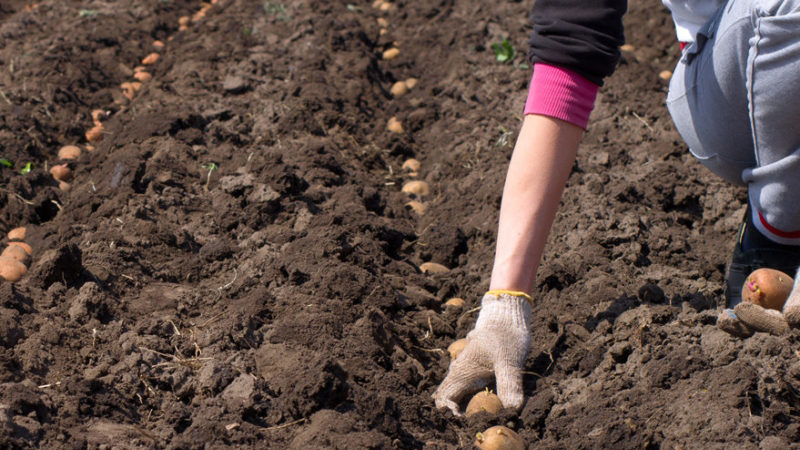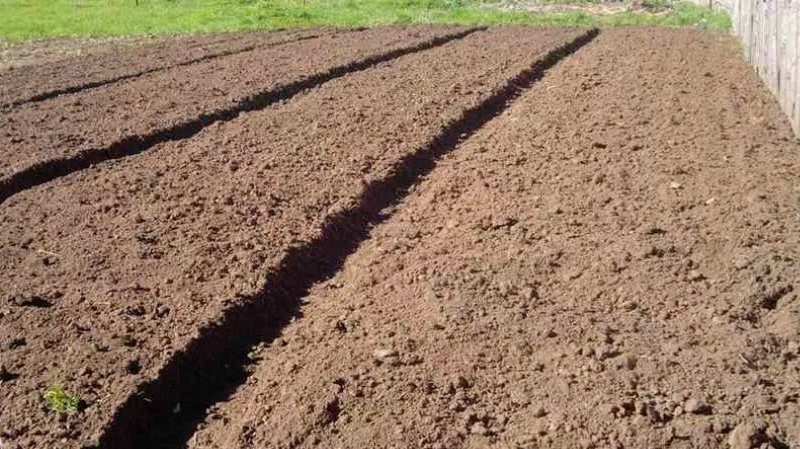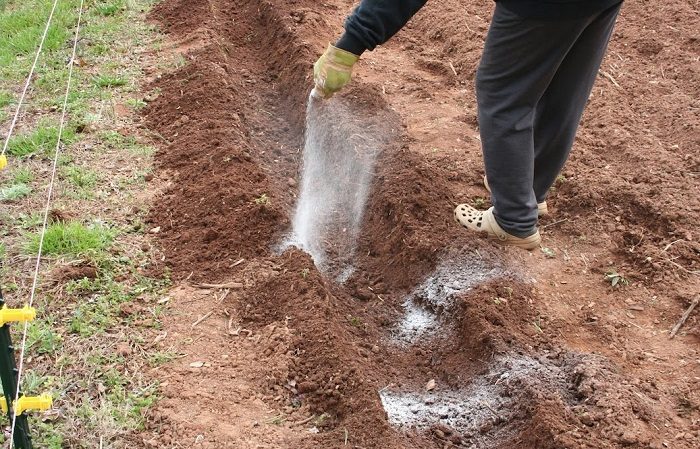Preparing the soil for planting potatoes: what acidity of the earth is needed
Potatoes in Russia are sincerely loved and called the second bread. But despite its ubiquity, many experience difficulties in growing it. Unpretentious potatoes are picky about the quality of the soil. We will show you what kind of soil is needed for potatoes and how to fix existing soil imperfections.
The content of the article
Features of soil for potatoes

The success of growing potatoes is largely determined by the soil. If soil fertility is easily increased by applying fertilizers, then parameters such as density and acidity can cause difficulties for a novice vegetable grower.
What soil does potatoes like
For potatoes, loamy soil is most suitable - rather fertile with a granular-lumpy structure, but good water and air permeability.
Similar in properties to loam sandy loam. With its lightness and plasticity, such soil resembles sandstone, but it is more fertile, since it is able to retain mineral and organic substances.
A good harvest can be obtained on peat soils and chernozems. Chernozem is the most fertile soil with a high content of humus (up to 15%), potassium, as well as organic and mineral compounds that make it possible to obtain phosphorus, nitrogen, sulfur. The structure is granular and lumpy.
Peat soils are not rich in humus, quickly absorb water, but also quickly give it away. They do not heat up well and often have high acidity. However, peatlands are easy to cultivate due to their ability to retain mineral fertilizers.
Less suitable for growing potatoes:
- Sandy soils - light and loose, but extremely poor in humus, therefore, they must be additionally enriched with nutrients. In addition, the sand does not retain moisture well, and in the summer heat the tubers can "burn".
- The main disadvantage of soils with a high clay content - high density, which means disturbed air and water exchange. In spring, alumina warms up later than other types; melt water often stagnates on them. Clay soils are most often acidic.

What soil acidity should be for potatoes
Potatoes prefer a middle ground - not too acidic or overly alkaline soil. The ideal pH range is 5.1 to 6.0. Such a soil is usually called slightly acidic.
From too acidic soil, it is difficult for a vegetable to absorb nitrogen, potassium, magnesium, phosphorus and calcium. As a rule, such soil is very heavy, so the plant has difficulty in accessing water, and the roots do not have enough space to branch well. In conditions of high acidity, pathogens actively multiply.
Alkaline soils are characterized by the presence of minerals in a poorly soluble form, so potatoes can suffer from deficiencies in magnesium, iron, boron and zinc. The alkaline reaction of the soil is typical for arid steppe and forest-steppe regions.
Soil processing before planting
Spring cultivation of the land for potatoes in the open field begins when the top layer dries out and warms up.
Before landing vegetables:
- The soil is dug up or loosened so that the earth is saturated with oxygen, and the roots can develop faster.
- Remove weeds so they do not shade furrows and compete with potatoes for nutrients and water.
- Fertilizers are applied to improve the quality of the soil.
How to determine the type and acidity of the soil

Its density, moisture capacity, water and air permeability depend on the type of soil in the summer cottage.... To determine the mechanical composition, the clod of earth is moistened and rolled between the palms into a sausage. Sandy and sandy loam soil crumbles immediately - no figure will come out of it. Clay soil and loam are plastic. To distinguish them from each other, the resulting sausage is folded into a ring: if it turns out, we have heavy alumina in front of us, but if the ring cracks, loam.
The acidity index affects the mineral composition of the soil: nutrients in conditions of extremely high or low pH are either absent or are in a form that is difficult for plants to digest.
The most reliable way to find out the acid-base reaction of the soil is to contact a specialized laboratory or use a digital analysis kit. However, there are other methods as well.
Read also:
Description and advice of agronomists on potato varieties: "Petersburg", "Barin", "Leader".
Folk ways
Vegetable growers from the people recommend:
- Carry out a vinegar reaction... Pour vinegar into a container with a little soil. If you hear a hiss and bubbles appear on the surface, the soil is alkaline.
- Repeat the same experiment with baking soda. A violent reaction in this case is a sign of acidic soil.
- In a bottle, mix 2 tbsp. l. land, 5 tbsp. l. water and 1 tsp. crushed chalk. Shake well and put a rubber fingertip on the neck. If after half an hour the soil mixture begins to emit gases and the fingertip swells, the acidity of the soil is increased.
- Prepare an infusion of bird cherry, black currant or cherry leaves (4-5 leaves per 1 tbsp. Boiling water). Cool the liquid, then add a lump of earth from the site. Acidic soil will turn red, slightly acidic - blue, neutral - green.
- Take a closer look at the weeds. Ivan da Marya, nettle, buttercup, oxalis, moss grow on strongly acidic soil; on neutral - bindweed, sow thistle and white sweet clover; in an alkaline environment - mustard and poppy seed. On slightly acidic soils that potatoes love, dandelion, coltsfoot, clover, chamomile, wheatgrass, cornflower grow well.
It should be borne in mind that these methods are not accurate and can give distorted results.
Litmus paper
A set of litmus paper is an affordable and more reliable way to determine pH:
- Take soil samples with different depths and preferably from different beds.
- Wrap each piece in three layers of gauze and place it in a sterile container of distilled water.
- Shake the liquid and place the litmus paper in it.
- The reagent will change color depending on the reaction of the medium: red - strongly acidic, pink - moderately acidic, yellow - slightly acidic, greenish-blue - close to neutral, blue - neutral.
It is recommended to take at least 10 samples. If they give different results, the average value is taken as true.
Features of soil deoxidation
For deoxidation, substances with an alkaline reaction are used:
- slaked lime;
- dolomite flour;
- wood ash;
- ground chalk;
- crushed eggshell;
- drywall - deposits of lacustrine-bog reservoirs;
- nitrate fertilizers;
- ready-made complex preparations ("Uglemuk", "Lime gumi").
The frequency and rate of alkalization depend on the initial pH values, soil density and the amount of humus in the soil. On heavy clay soils, the deoxidation effect will last longer, therefore, the preparations are applied in larger quantities, but at intervals of 5-7 years.
Reference. The green manure plants also help to level the acidity: vetch, phacelia, rye, lupine, oats, legumes.However, it is necessary to sow the site with them in advance - during the autumn soil preparation.
How to acidify the soil
If the reaction of the soil is closer to alkaline, organic fertilizers are introduced into it: compost with the addition of rotted needles and sawdust, high peat, fresh manure.
Organic matter delicately acidifies the soil, additionally makes the soil looser and more breathable. If you need a quick result, use mineral compounds: ferrous sulfate, ammonium nitrate.
Reference. Colloidal sulfur significantly lowers the pH, however, it acts slowly, therefore, it is mainly brought in for autumn digging (100 g per 1 sq. M). They also come with ammonium sulfate and potassium sulfate.
Ways to improve soil quality
Knowing the characteristics of the soil, you can significantly improve its quality:
- lighten or tighten;
- enrich with humus;
- even out mineral imbalances.
Fertilizers
Fertilizers are classified as organic and mineral. The former are valued for their naturalness, ease of assimilation, and rich chemical composition. Mineral mixtures are good when one or more substances are required in a certain dosage.
For planting potatoes, first of all, nitrogen-containing compositions are used, since they accelerate the growth of green mass in plants:
- fresh or semi-rotten cow dung;
- compost;
- urea (carbamide);
- ammonium nitrate;
- complex mineral fertilizers ("Ammophos" and "Diammophos").
However, the most important element for potatoes is potassium, and preferably in sulfate form. In turn, potassium is well absorbed if used in conjunction with phosphorus fertilizers: phosphate rock, simple and double superphosphate, as well as in the form of combined mixtures - "Nitrofoski" and "Nitroammofoski".
Reference. These fertilizers are applied, evenly spreading over the area of the site for digging or directly into the hole during planting.
Siderata
Siderata are used:
- to scare off pests;
- for soil rehabilitation;
- for soil enrichment with useful microelements.
In the spring, sowing of green manure begins immediately after the snow melts. For this purpose, cold-resistant plants are chosen, since they must emerge in conditions of low temperature, and by the time the potatoes are planted, they must already have adult shoots. Mustard, rapeseed, rye, oats, phacelia meet the stated requirements. If you plan to grow siderates at the same time as potatoes in the aisles, the choice falls on legumes, calendula and nasturtium.
To scare away insects and prevent diseases, mustard and rape are used - against wireworm and phytophthora, flax - against the Colorado potato beetle.
Reference. The ideal spring green manure before planting potatoes is phacelia. It is frost-resistant, loosens the soil well, increasing its air permeability, reduces soil acidity, helps in the fight against root nematode, repels locusts, suppresses the spread of root rot and late blight, displaces weeds.
Disinfection
To protect potatoes from pathogenic fungi, bacteria and viruses, tubers and soil are treated:
- a weak solution of potassium permanganate;
- copper sulfate;
- boric acid;
- bordeaux liquid;
- ash.
For more reliable protection, fungicides of industrial production are used: "Fitosporin", "Quadris", "Maxim", "Immunocytofit", "Prestige" and others. When using them, you must strictly follow the directions on the package and do not exceed the recommended dose.
Ash

Ash is an excellent natural fertilizer. It has an impressive chemical composition, in which calcium and potassium occupy a special place.
The main purpose of ash before planting potatoes is to increase the plant's resistance to various diseases and disinfect the soil. Good results are obtained by applying fertilizer directly to the hole.
Attention! Ash does not mix well with fresh mullein, so it is better not to use them at the same time. But it is effective in combination with peat and compost.
Loosening
Potatoes are very fond of loose, oxygen-filled soil. In such conditions, nothing interferes with the development of its root system and the formation of large tubers.
Loosening the soil before planting potatoes should be thorough - to a depth of 15 to 30 cm. It is advisable to loosen alumina and loam in two steps to avoid stagnant water. The site is dug to the depth of the shovel bayonet, then the clods of earth are broken with a rake.
Reference. Sometimes the usual loosening and digging is not enough. Then the heavy soil is lightened by adding sand, crushed sifted bricks, and plant residues burnt together with the earth.
How to choose the right place on the site for growing potatoes
When choosing a place for organizing potato furrows, take into account:
- Illumination of the site. Potatoes love light. In partial shade and shade, the tops develop slowly, and the tubers are small and in small quantities.
- Humidity. The vegetable cannot be planted in the soil with stagnant water - the seed will rot before it has time to start growing.
- Windproof. Preference is given to areas planted with trees or shrubs on the north side. This will protect the soil from erosion, and planting from hypothermia.
Conclusion
What is the best soil for potatoes? It is important that the soil is light, slightly acidic and sufficiently nutritious. The competent application of fertilizers and agricultural techniques, multiplied by patience and time, will give a good yield even in initially unfavorable conditions.